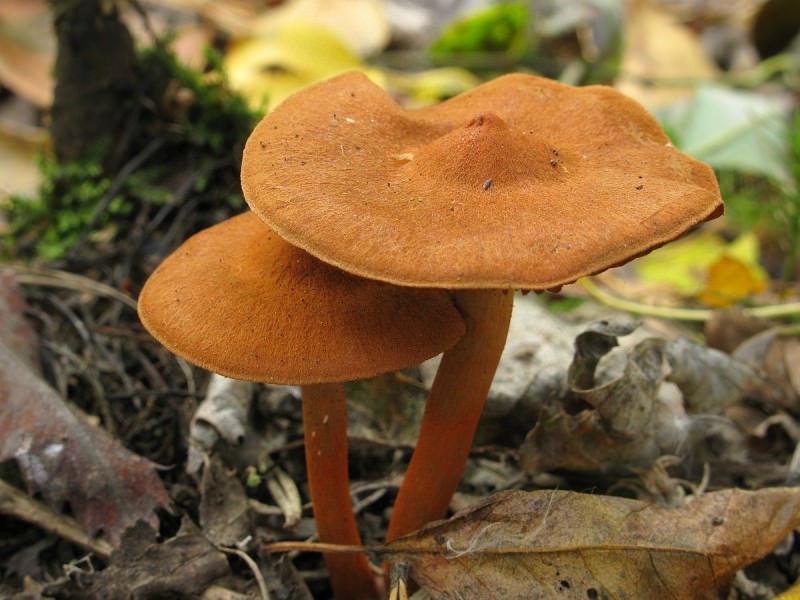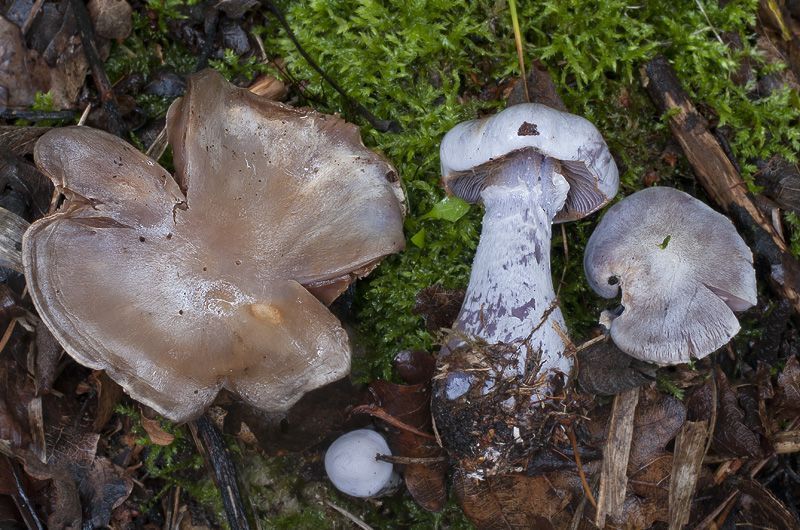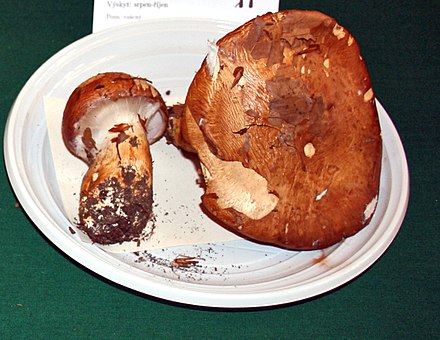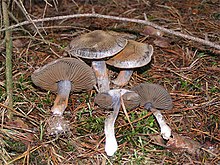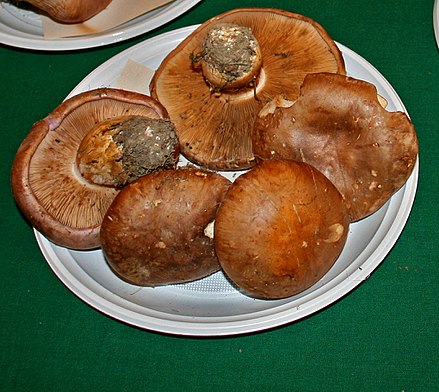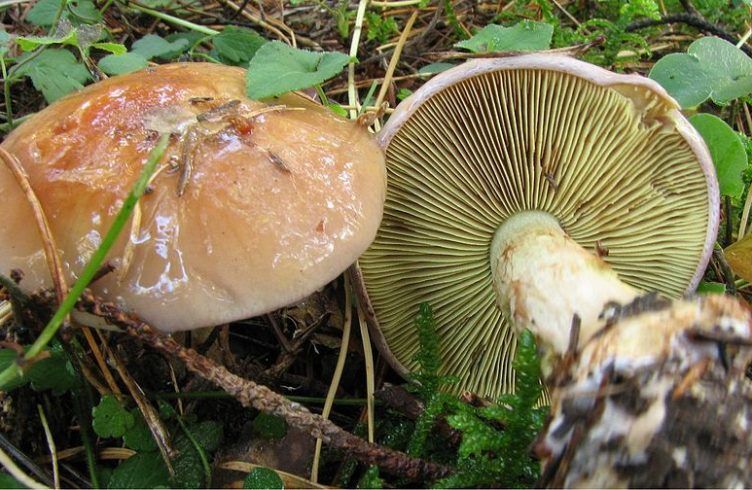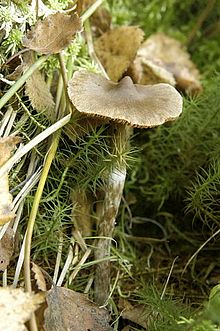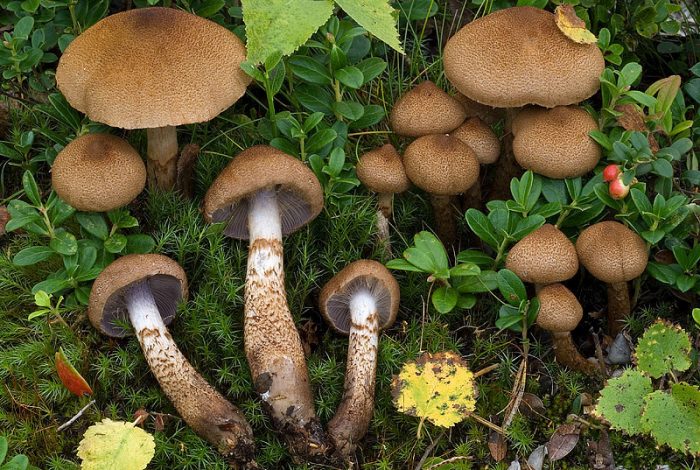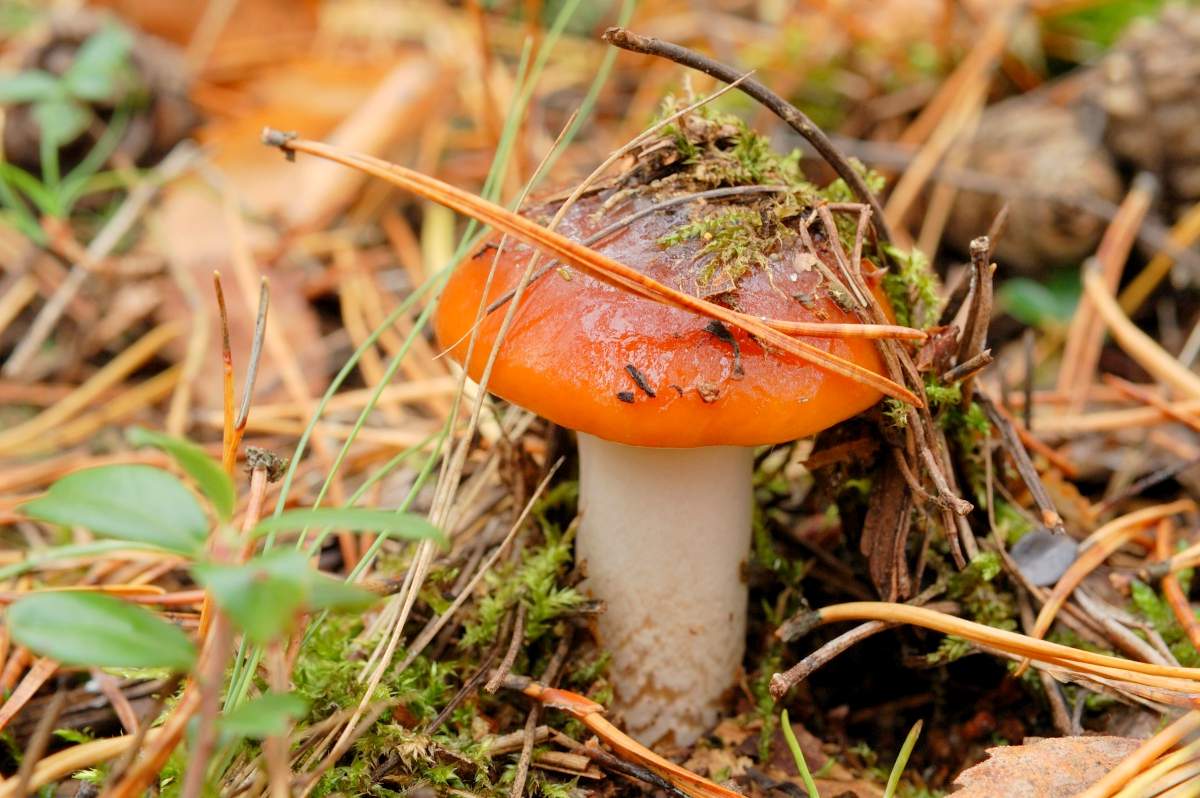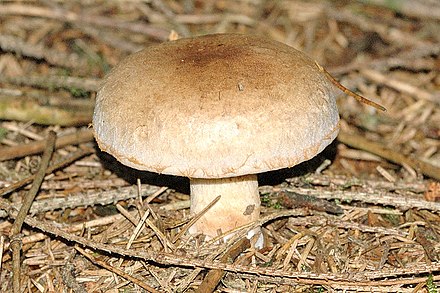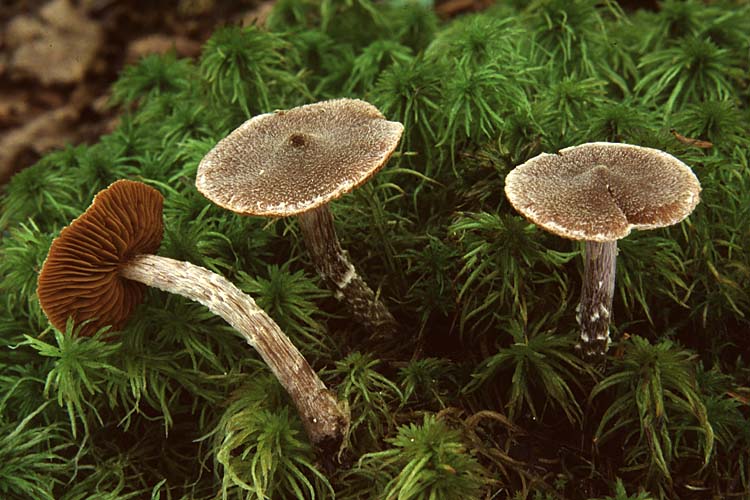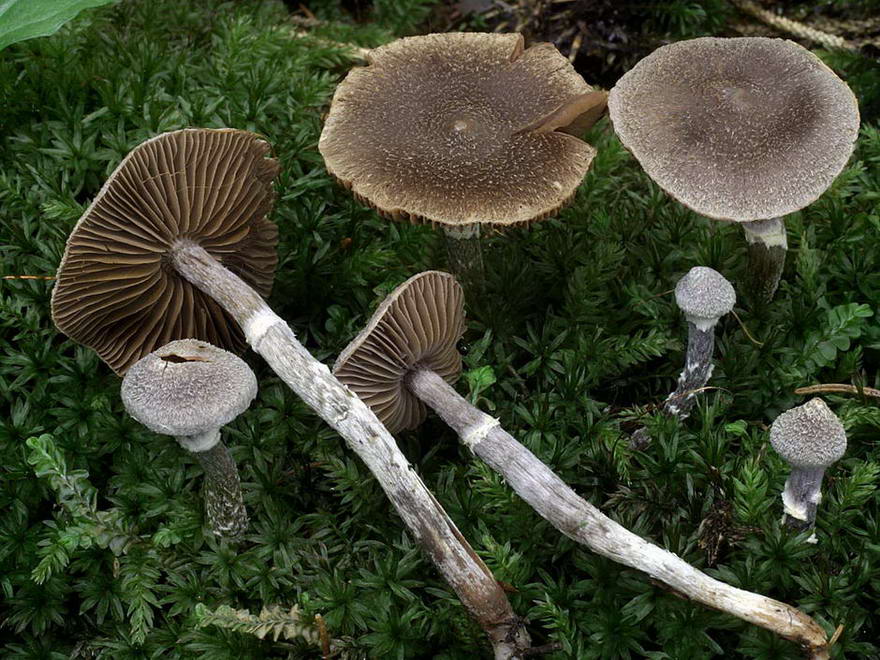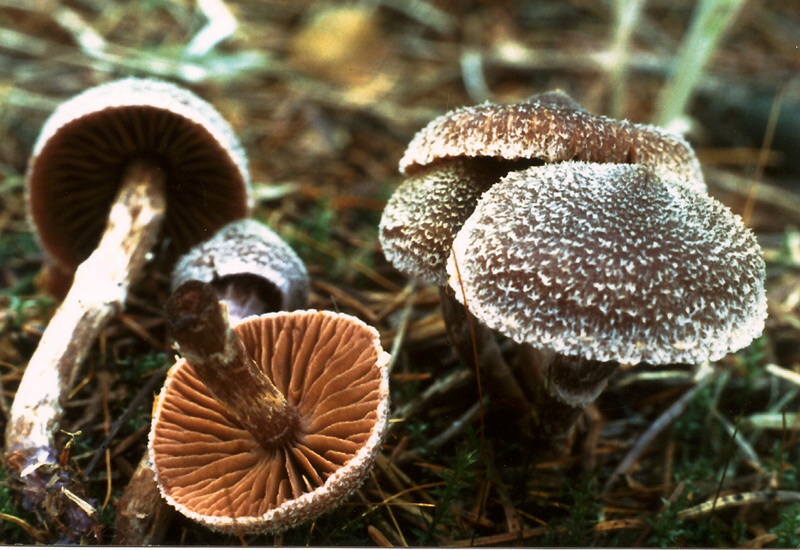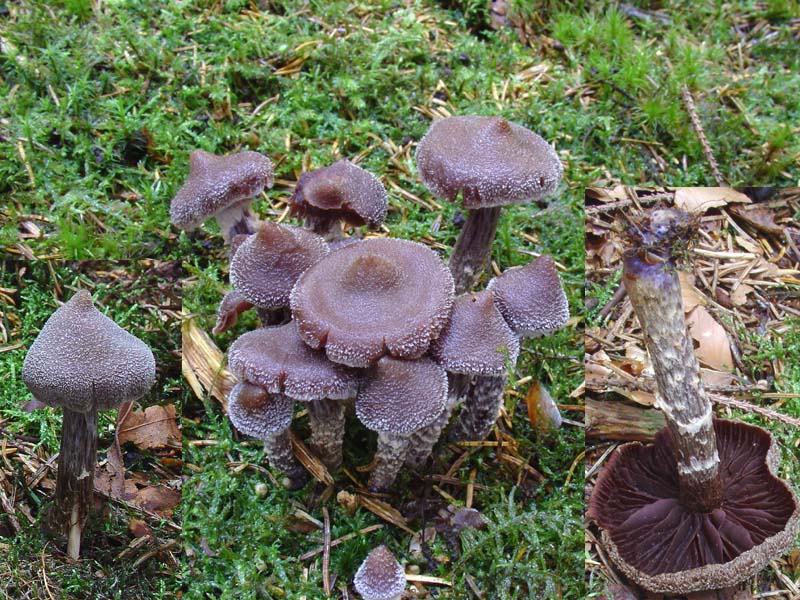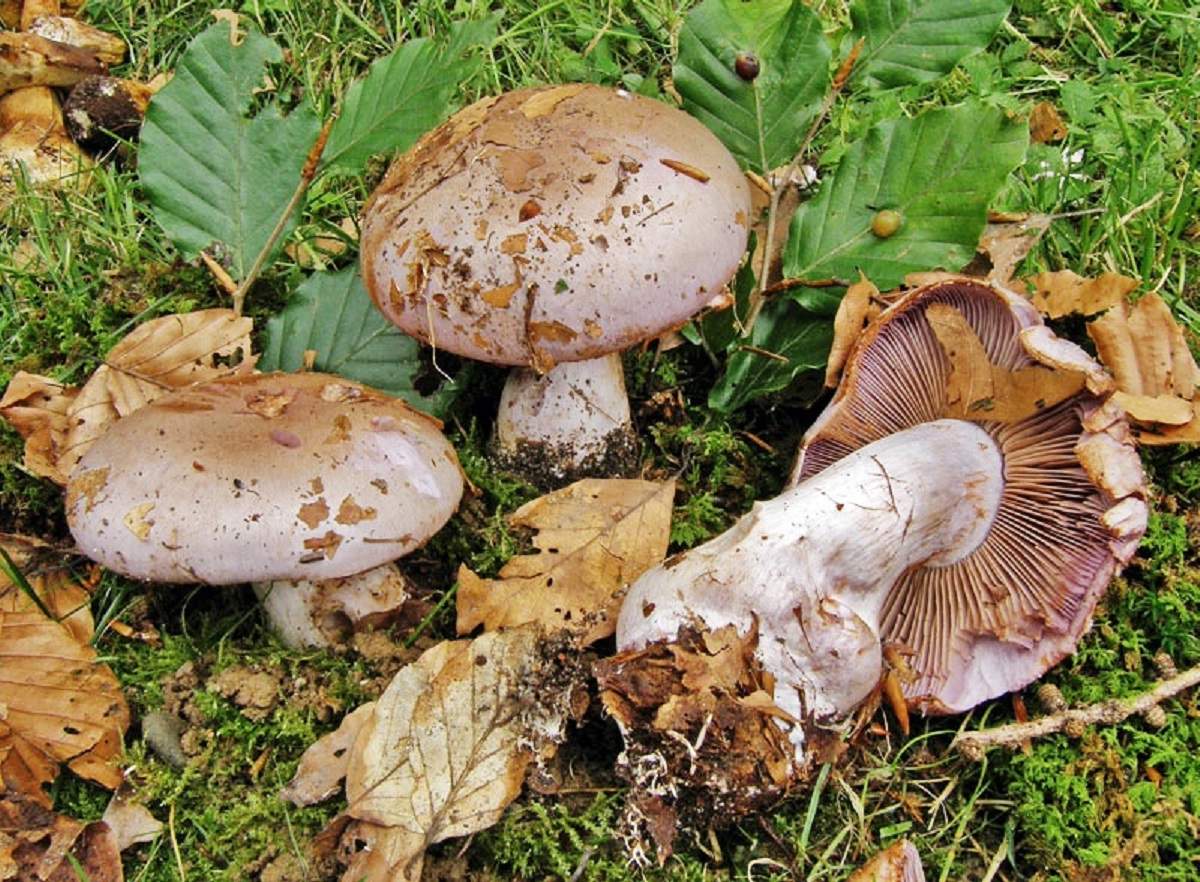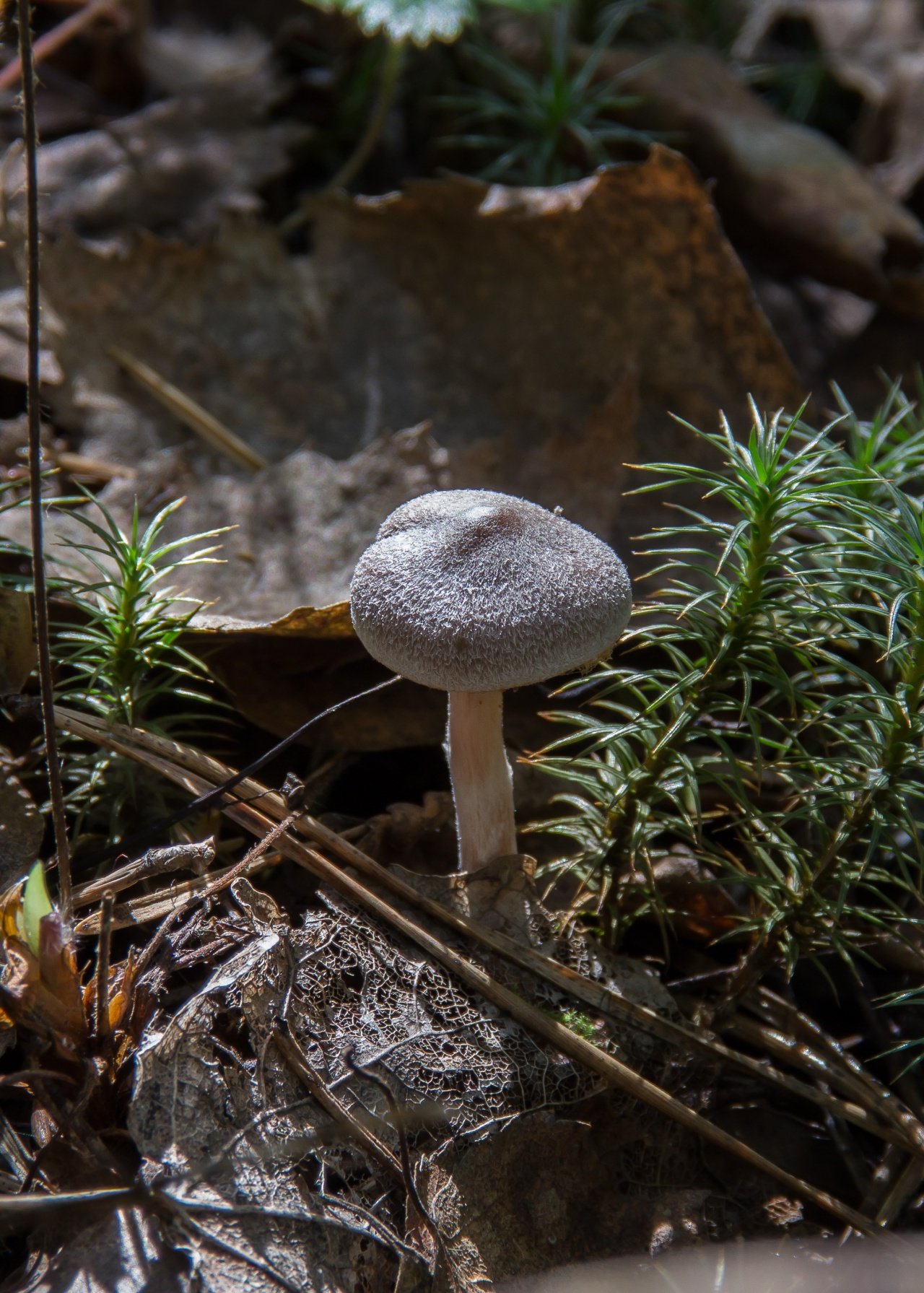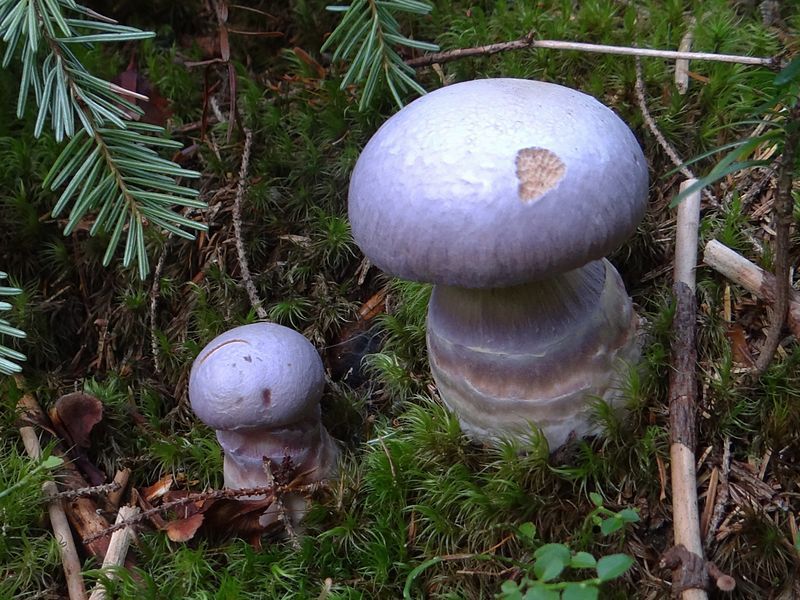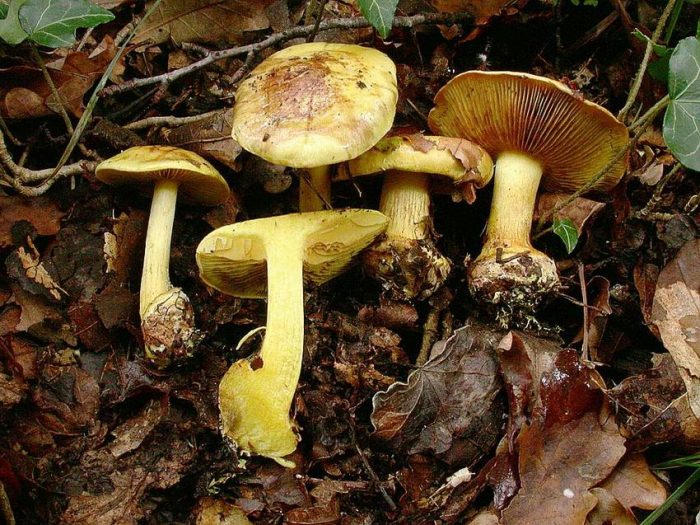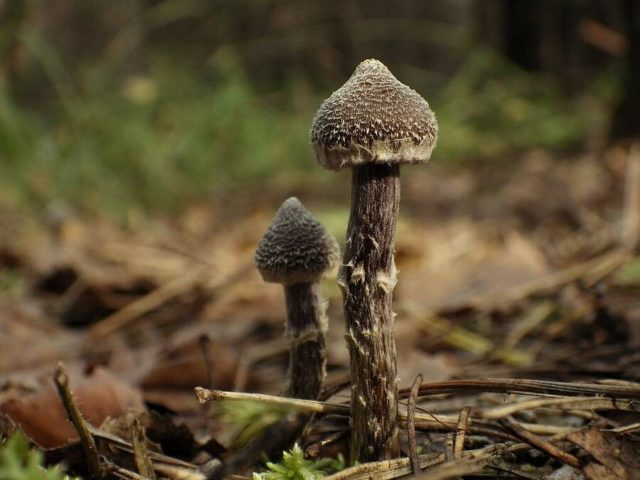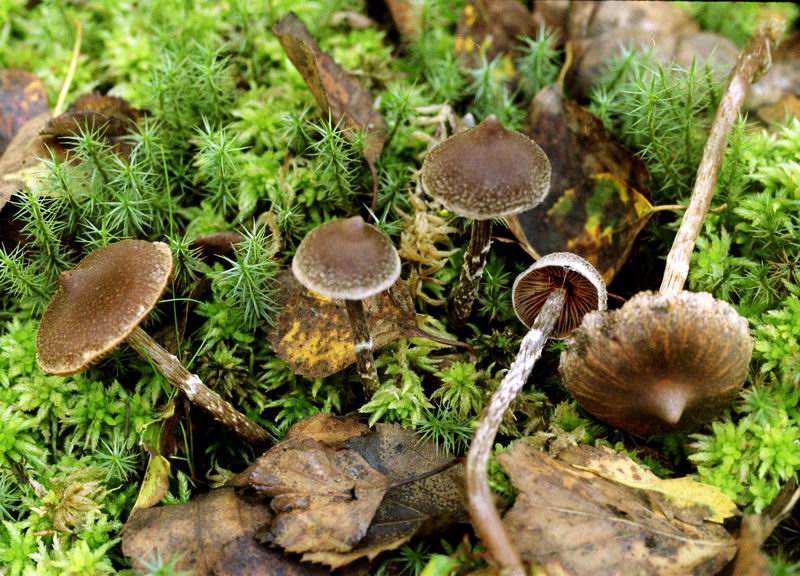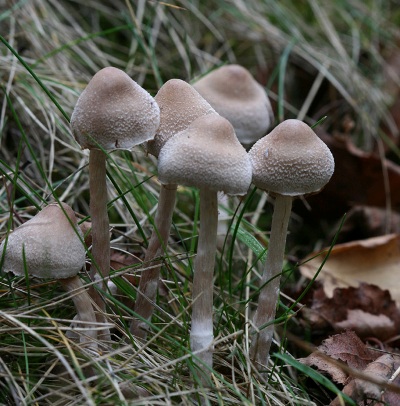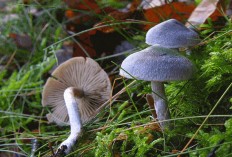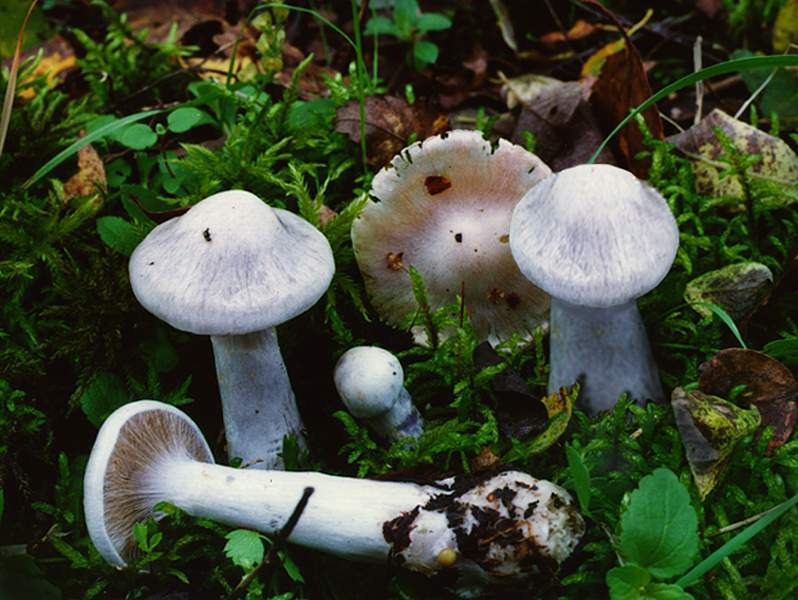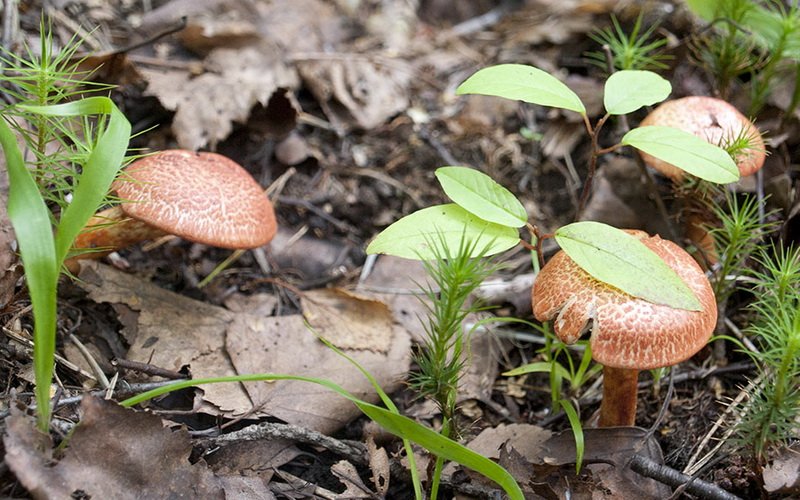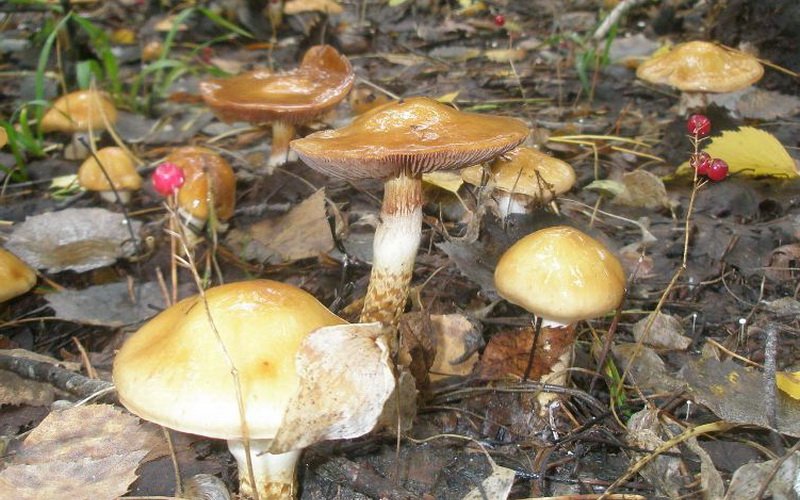Superb webcap (Cortinarius praestans)
The excellent webcap (Cortinarius praestans) is a mushroom belonging to the Spiderweb family.
External description
The fruit body of the excellent spider web is lamellar, consisting of a cap and a leg. On the surface of the mushroom, you can see the remains of a spider web.
The diameter of the cap can reach 10-20 cm, and its shape in young mushrooms is hemispherical. As the fruit bodies ripen, the cap opens to a convex, flat, and sometimes even slightly depressed cap. The surface of the mushroom cap is fibrous and velvety to the touch; in mature mushrooms, its edge becomes pronouncedly wrinkled. In immature fruit bodies, the color is close to purple, and in ripe ones it becomes red-brown and even wine. At the same time, a purple tint is preserved along the edges of the cap.
The hymenophore of the fungus is represented by plates located on the back of the cap and adhered to the surface of the stem with their notches. The color of these plates is grayish in young mushrooms, and beige-brown in mature ones. The plates contain a rusty-brown spore powder consisting of almond-shaped spores with a warty surface.
The length of the leg of the excellent spider web varies within 10-14 cm, and the thickness is 2-5 cm. At the base, a tuberous thickening is clearly visible on it, and the remains of the cortina are clearly visible on the surface. The color of the leg in immature excellent spiderwebs is represented by a pale purple tint, and in mature fruit bodies of this species it is pale ocher or whitish.
The pulp of the mushroom is characterized by a pleasant aroma and taste; it acquires a brown color in contact with alkaline products. In general, it has a white, sometimes bluish color.
Season and habitat
The excellent webcap (Cortinarius praestans) is widespread in the nemoral areas of Europe, but is rare there. Some European countries have even included this type of mushroom in the Red Book as rare and endangered. The fungus of this species grows in large groups, lives in mixed and deciduous forests. May form mycorrhiza with beech or other deciduous trees growing in the forest. It often settles near birches, begins to bear fruit in August and gives good yields throughout September.
Edibility
The superb webcap (Cortinarius praestans) is an edible but little-studied mushroom. It can be dried, and also can be eaten salted or pickled.
Similar types and differences from them
The excellent spider web (Cortinarius praestans) has one similar species - the watery blue spider web. True, in the latter, the cap has a bluish-gray color and a smooth edge, covered with a cobweb cortina.
Dangerous doubles
The spiderweb family is relatively monotonous, only mushrooms of a clearly blue hue have the greatest difference, the rest can be confused one way or another
The webcap is yellow edible or not - everyone needs to decide on their own, it is important that it is non-poisonous
| Name | External features | Places and times of growth | Danger |
Pantaloons triumphal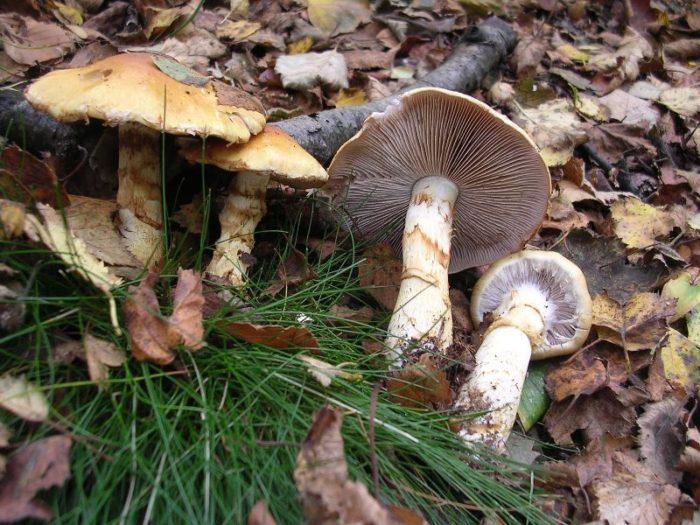 |
Yellow cap with a brown center, yellowish stem, with obvious rings | Mycorrhiza forms with birches, can be found in conifers. Aug. Sept | Conditionally edible |
Common webcap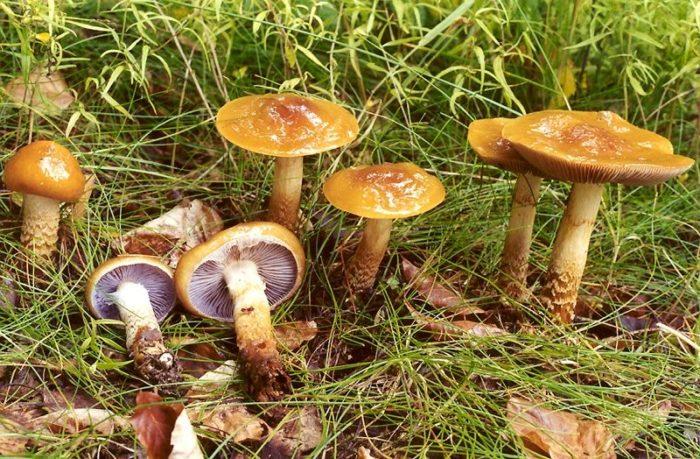 |
The hat is yellow with an olive tint, brownish, very slimy, the leg is white with a purple tint, the belts are weak | Grows with aspen, alder and birch, found in deciduous and mixed forests, rarely in conifers. July - September | Inedible |
Bracelet webcap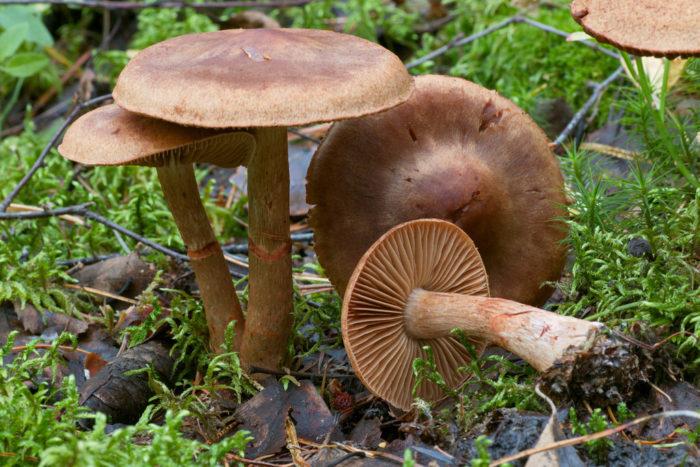 |
Dry orange cap, may have a reddish tint, covered with dark fibers, the belts on the leg are red-brown | Mycorrhiza forms with birch, pine, prefers more humid places. August - November | Conditionally edible |
The webcap is beautiful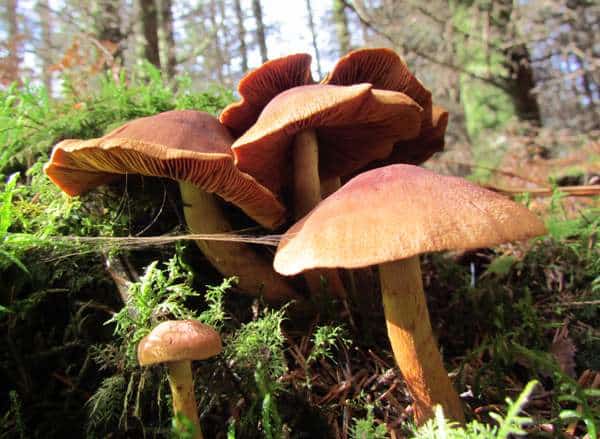 |
The surface of the cap is red-orange, scaly, the stem repeats the shade with the addition of ocher color, the belts are lemon-yellow or ocher | Grows in coniferous forests from May to September | Poisonous |
Upon careful examination of the forest find, it will be quite easy to distinguish one spider web from another; in case of doubt, it is better to leave the mushroom in place and not take it to the basket.
External description
The appearance of the olive-red cobweb is quite beautiful and attractive. The cap with a diameter of 6 to 12 cm, initially, in young mushrooms, has a spherical shape and a mucous surface. A little later it opens up, becoming widespread and acquiring a deep purple color along the edge. The middle of the cap in mature mushrooms becomes purple-purple or slightly reddish. The hymenophore is represented by the lamellar type. Its constituent components are plates, which initially have an olive-yellow color, and as the mushroom matures, they become rusty-olive. They contain spores characterized by an almond shape, a light yellow tint and a warty surface. Their dimensions are 12-14 * 7-8 microns.
The upper part of the mushroom leg has a pronounced purple color, turns purple-red from top to bottom. The thickness of the leg of the red-olive spider web is 1.5-3 cm, and the length is from 5 to 7 cm. At the base, the stem of the fungus expands, acquiring a tuberous formation.
The mushroom pulp is very bitter in taste, characterized by a slightly purple or olive green tint.
Interesting Facts
The triumphal webcap got its name due to the color, which resembles the golden crown of the victorious generals in ancient Rome.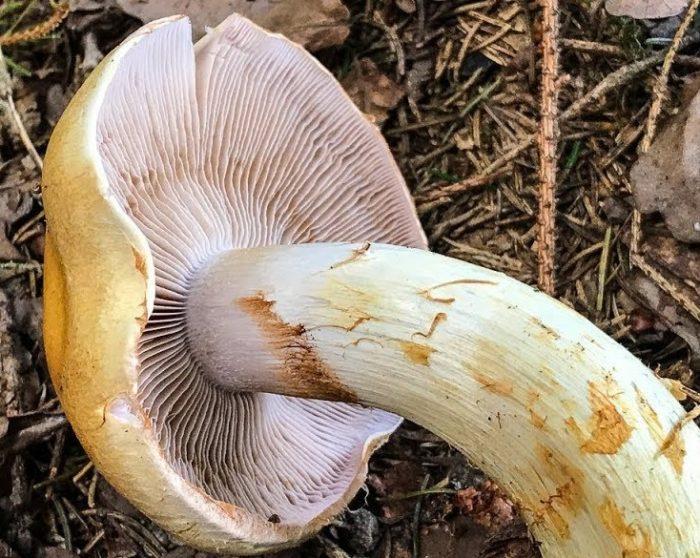
Often mushroom pickers have to choose between a cobweb and a black mushroom, because they grow at the same time, as a rule, next to each other, but it is quite difficult to cope with harvesting two types of mushrooms at once. Usually, the choice is not in favor of the pimp, and therefore he remains in the forest.
The pulp of this mushroom does not change color at the break, but dries quickly enough. The absence of an unpleasant smell and good taste make the yellow spider web one of the most delicious of its kind.
When the triumphal cobweb is boiled, it is often noticed that its broth is very transparent, the mushroom remains beautiful and crispy. These advantages make it more competitive among the fruits of the autumn forest.
Mushrooms are popular forest fruits that should only be harvested with complete confidence in their edibility. The yellow webcap is a tasty conditionally edible specimen, it is easy to distinguish it, but in case of the slightest doubt, it is better not to take it. The preparation of this species is simple, it grows in large families, and therefore a rich harvest is ensured.
Filmy webcap: photo and description
| Name: | Filmy webcap |
| Latin name: | Cortinarius paleaceus |
| Type of: | Inedible |
| Specifications: |
|
| Systematics: |
|
The scarlet webcap (Cortinarius paleaceus) is a small lamellar mushroom from the Cortinariaceae family and the Cortinaria genus. It was first described in 1801 and received the name sinuous champignon. Its other scientific names: winding webcap, given by Christian Persun in 1838 and Cortinarius paleiferus. Previously, all these mushrooms were considered different species, then they were combined into one common one.
Description of the filmy webcap
The fungus does not grow large. Depending on weather conditions, it is able to change its color and pulp density.
Only sprouted fruiting bodies have an attractive appearance.
Description of the hat
The filmy webcap at a young age has a bell-shaped cap, with a noticeably elongated papillary tubercle at the apex.As it develops, the cap straightens out, becoming umbrella-shaped, and then outstretched, with a cone-shaped tubercle in the center. The surface is uniformly colored and has lighter radial stripes. Covered with golden straw or white bristles, velvety, dry. The color is chestnut, dark brown. When dry, it becomes pale fawn. The diameter of the cap is from 0.8 to 3.2 cm.
The plates of the hymenophore are frequent, uneven, free or dentate-enlarged. Color from beige-cream to chestnut and rusty-black-brown. The pulp is thin, fragile, ocher, black-violet, light chocolate or rusty-brown shades, has a light geranium aroma.
In wet weather, the caps become slimy-shiny
Leg description
The stem is dense, firm, longitudinally fibrous. It can be curved, hollow inside, the pulp is rubbery, elastic, rusty-brown in color. The surface is dry, covered with a white-grayish downy. Sizes reach 6-15 cm long and 0.3-0.9 cm in diameter. The color is beige, violet-brown, black-brown.
With respect to the cap, the legs of the fruit bodies can reach significant sizes.
Where and how it grows
The filmy webcap lives in Europe and North America. In Russia, his colonies were seen in the Kedrovaya Pad nature reserve in the Far East. Its distribution area is wide, but it can be found infrequently.
Grows in mixed coniferous-deciduous forests from mid-summer to September. He especially loves birch groves. Prefers wet places, ravines, lowlands, drying up swamps. Often grows in moss. It settles in large groups of separately separated fruit chalk of different ages.
Is the mushroom edible or not
The crayfish webcap is classified as an inedible species due to its low nutritional value. There are no exact data on the substances contained in it in open sources.
Doubles and their differences
The filmy webcap has similarities with close relatives.
Webcap gray-blue ... Conditionally edible. Differs in larger, up to 10 cm, in size and silvery-bluish, beige-ocher color.
The leg has a light color: white, slightly blue with reddish-sun spots
The webcap is semi-hairy. Inedible. Differs in large size and light color of the leg.
The legs of these mushrooms are medium in size and quite fleshy.
Conclusion
Filmy webcap is a small rare mushroom from the webcap genus. Found in the Northern Hemisphere everywhere, but not too abundantly. In Russia, it grows in the Far East. Prefers the neighborhood with birches, the outskirts of bogs, feels great in mosses. Inedible, has twins.
Webcap purple

The purple webcap (Latin name - Cortinarius Violaceus) is an edible mushroom of extraordinary beauty. Quite often it can be found in deciduous and coniferous forests. This plant is listed in the Red Book of the Russian Federation, as it is a very rare species of mushrooms.
The webcap belongs to the Lepista genus, to the Buttercup family. The following characteristic will present all the features of this plant.
Edible: conditionally edible.
Description
The purple spider web, or sometimes it is called the purple spiderweb, is the adornment of any forest. Despite the fact that it is conditionally edible, it is not recommended to collect it due to its uniqueness. During the mushroom season, it can be found only once. Its number decreases every year.
The mushroom cap can be up to 15 cm in diameter. It can be hemispherical or flat. There is a tubercle in the center. A young mushroom has a purple cap. In rare cases, its color may be red. It can fade over time. In the lower part there are wide plates.
The pulp at the break has a blue tint, and the smell of the mushroom is almost not felt. The pulp is quite fragile, it is easy to break it in your hands.
The stem of the mushroom is long and pleasant to the touch. The same can be said about armor. A thickening can be seen towards the base. During maturation, the stem can become tubular. The outer layer of the fungus is purple in color.
Where do they grow?
Very often, a purple cobweb can be found in damp birch forests. It can appear under spruce and pine trees. The most popular are single specimens, but groups of cobwebs are also rare.
Types of cobwebs
There are many varieties of cobwebs. The following are the most common ones:

• White and purple spider web. This mushroom cap belongs to the lamellar group. Its cap can reach 12 cm in diameter, and its edges are connected to the stem with a cobweb blanket. The flesh of the mushroom can be brown or light brown. It tastes and smells good.

• Scaly webcap. Its cap can be about 10 cm in diameter, it is convex or flat. In wet weather, it is slimy and shiny.

• The webcap is yellow. The most common representative of cobwebs, sometimes it is called yellow or triumphant spiderweb.
Beneficial features
The webcap contains many vitamins. It is composed of B1 and B2, zinc, copper, manganese. This mushroom is characterized by stearic acid and ergosterol. The medicinal properties of this plant are noted by many pharmacists. Such a conditionally edible mushroom is used in the manufacture of remedies for fungus, antibiotics. It is able to lower glucose levels. It can also be used to create drugs that control hypoglycemia. The cobweb has anti-inflammatory properties, it perfectly supports the activity of the immune system. Due to the large amount of vitamins, it helps to normalize the digestive tract, it also protects the body from infections and prevents overwork, fatigue.
Contraindications
If you take into account how much benefit this mushroom has in itself, you can understand that the contraindications here are insignificant. Some edible mushrooms can be confused with inedible mushrooms. The threat is posed by cobwebs that were collected near the road. They managed to absorb all the toxic substances. Such mushrooms are contraindicated for people with gastrointestinal diseases.
How to make a purple spider web salting?
To salt such a mushroom, it must be thoroughly washed and cleaned of contaminated areas. Then they are boiled in salted water. The water needs to be drained and then you can proceed to pickling the mushrooms.
You need to marinate them with vinegar, sunflower oil, salt and pepper. The mushrooms need to be immersed in a saucepan, add the listed ingredients and put on low heat. Spiderweb mushrooms will secrete a liquid in which salting occurs. Then they can be laid out in banks and stored for no more than 12 months in a cool place.
Recipes for the winter
Cooking a yellow webcap is easy because the process is quite simple. The mushroom does not require soaking and boils quickly. It will take a little patience and time to prepare it for the winter.
Salting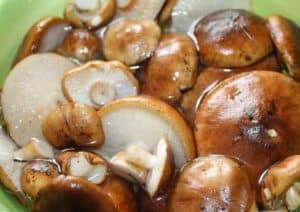
Pre-boiled mushrooms are placed in a prepared container, sprinkling each layer with salt. There should also be salt below and above. It is not necessary to use any spices for salting, the spider web is good in its natural form, its taste will be excellent. On top, put cheesecloth folded in several layers, a plate and press everything down with a load.
After 2-3 days, the mushrooms will be covered with brine, you need to periodically rinse the gauze or change it to a new one. This will help to avoid the appearance of mold. After 3 weeks, you can try the mushrooms.
Many housewives add various spices to improve the taste of salted mushrooms. May come in handy:
- Bay leaf;
- Dill;
- Carnation;
- horseradish and currant leaves;
- garlic and others.
You can use them at will, the proportions are also respected at personal discretion.
Drying
If you want to keep the cobwebs in a dried form, then preliminary boiling is not required. It is better not to wash the mushrooms, it is enough to clean the forest debris. After that, string on a string and hang in a sunny, well-ventilated place.
You can dry the fruits in the oven, for this, the oven is heated to 70 degrees, the pans on the baking sheet are installed inside.Turn them over from time to time to dry evenly. After 6-7 hours, the mushrooms are removed. Fruiting bodies should be cooled and placed in a closed container. Store in a dark place free of foreign odors.
Canning in jars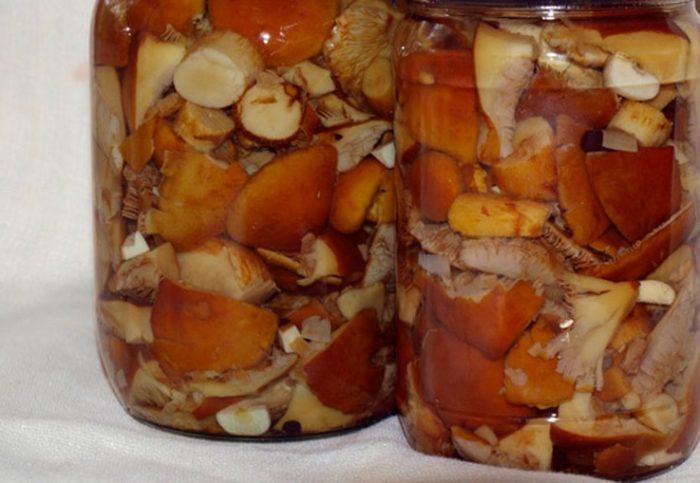
In order to preserve the podolotnik, for 2 kg of mushrooms you will need:
- salt - 300 g;
- dill - 3 umbrellas;
- horseradish leaf - 3 pcs.;
- garlic - 3 cloves;
- vegetable oil - 200 ml.
Cooking process:
- The washed and peeled mushrooms should be boiled in salted water for 40 minutes.
- Arrange the fruits in jars, add dill, garlic to each, and place a horseradish leaf on the bottom.
- Pour everything with broth, add 2 tbsp. To each jar on top. l. oils.
- Now you can roll up, cool and put away in a cool dark place.
This recipe is very simple, the main thing is that the jars are pre-steamed with boiling water and completely clean.

